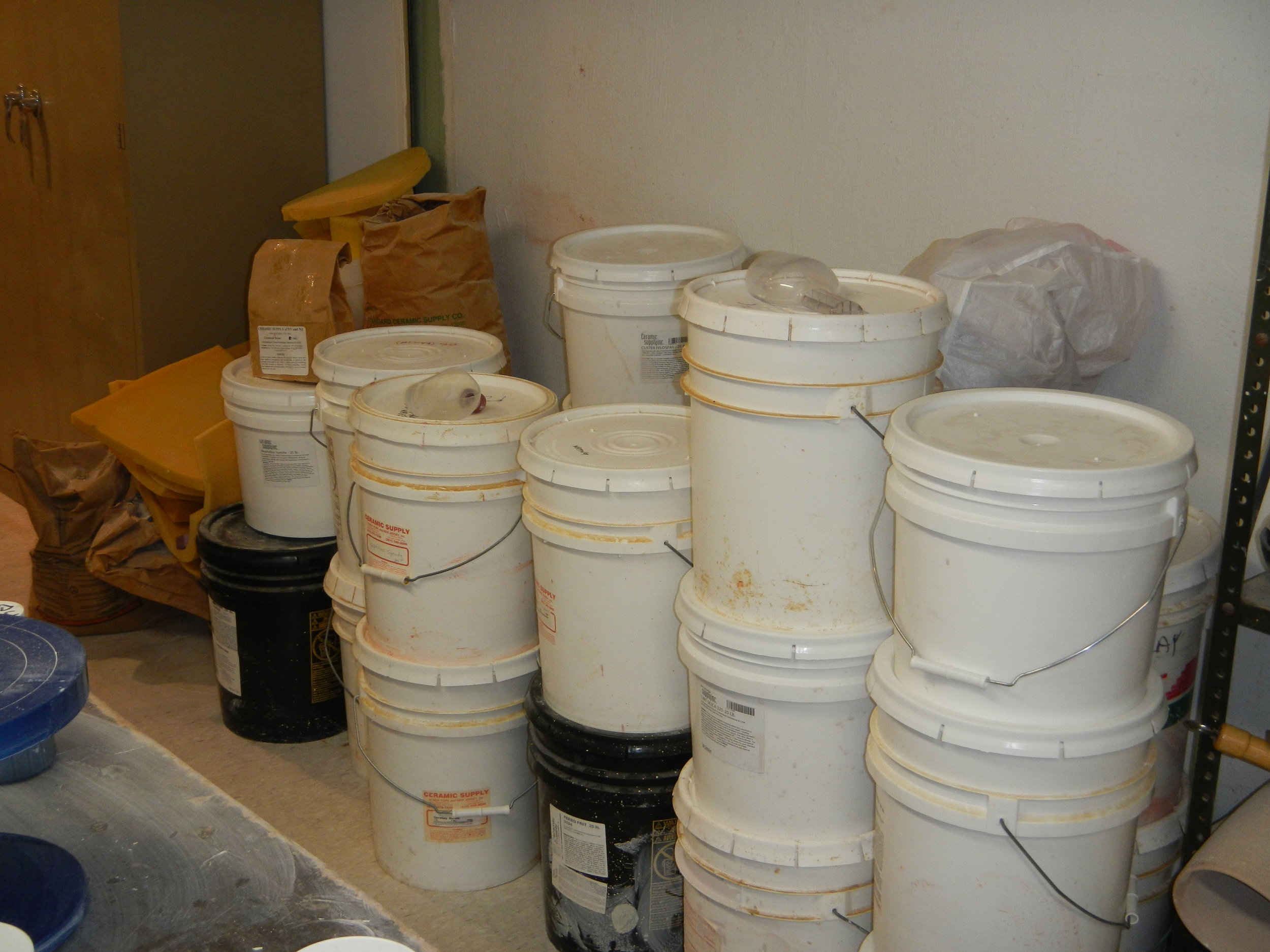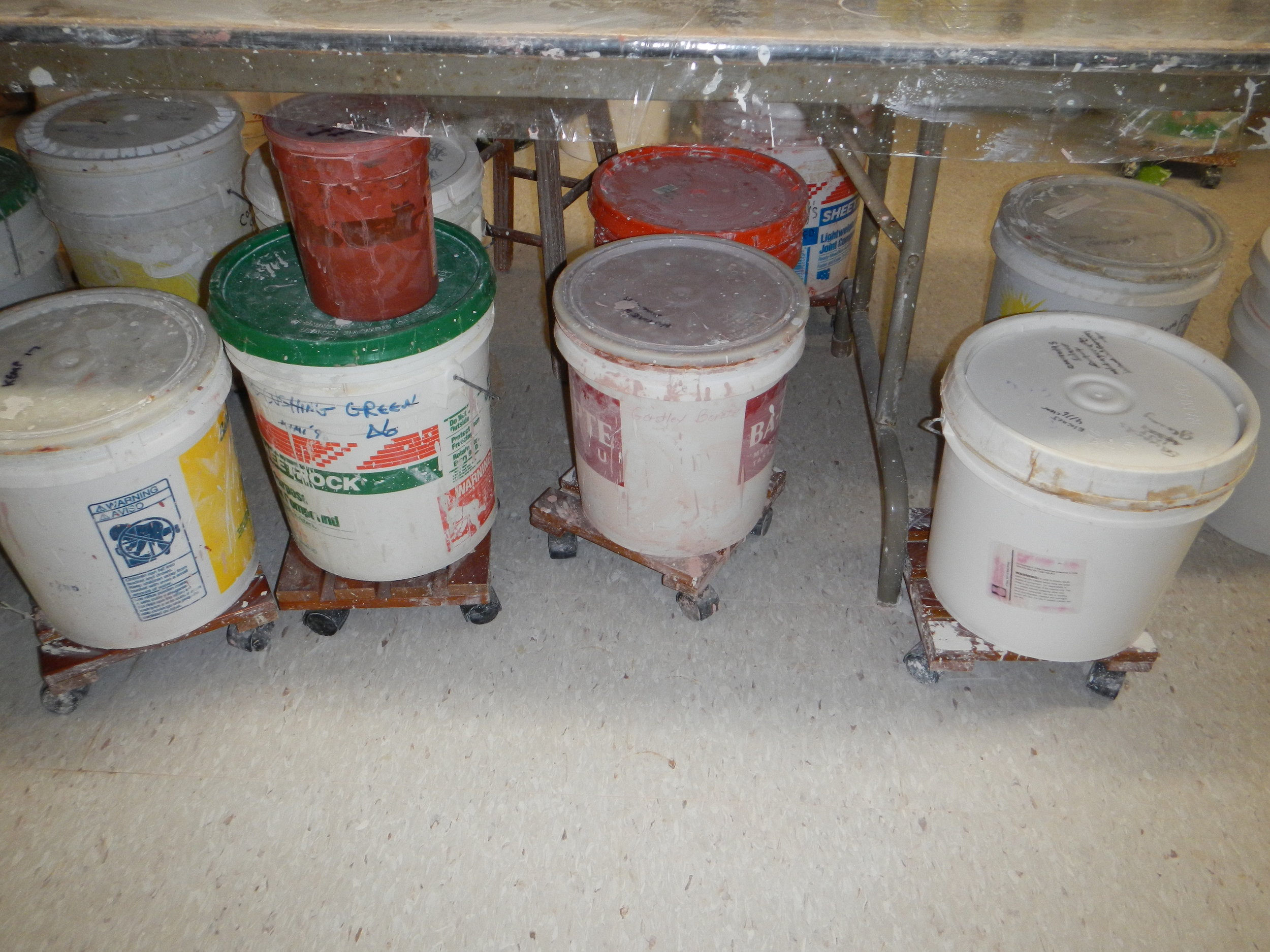Tour!
Two wheels, one a motorized Lockerbee kickwheel (two options, electric power or kick power) and one a Brent electric.
A slab roller, 48x36 inches of clay-rolling capability, with two canvas cloths on top and two knurled (like that word, "knurled") metal rollers, plus a a ship's wheel handle to turn the rollers.
...and glaze color samples and random pottery photos on the walls and an air purifier and dehumidifier...
Plenty of boxes of clay, most fresh (in boxes in the corner), some old and long unused (under the slab roller table) which lately I've been reclaiming to workable consistency 25 lbs at a time, and some there for no good reason any more (under the work table in buckets, rock hard and dry- and they need to go out).
Two kilns, one I use a lot (digital controller) and one I hardly use (the old one with a manual turn-up and junior cone system, which I use in crunch time for bisque firing when the other one is in use).
...in my kiln room, which used to be a storage area...
Tools. Jars and small buckets and mugs and big containers full of all sorts of tools. Throwing tools. Glazing tools. Carving, cutting, rolling, texturing, joining and shaping tools.
...one place out of several where you can find tools...
Glaze ingredients. Buckets of powdered ingredients. Their names are a language of its own: Dolomite, flint, talc, gerstley borate, wollastonite, kaolin, frit, Cornwall stone, nepheline syenite. A cabinet of more ingredients in bags and jars: glassifiers, opacifiers, stiffeners, melters, and colorants like powdered stains and carbonates and oxides. Buckets and buckets and bags and jars of ingredients I bought and a few, inherited. And pages of glaze recipes to be tried, or recipes that were tried and good enough, or recipes tried and great. The ones I use are in a yellow contractor's book that has wipe-down pages.
Buckets and buckets of glazes we've made from recipes out of those powders, my sometime helpers and I. Full buckets, half full ones, ones that need refills again, ongoing. Buckets of glazes in ten or twelve colors. Raw glazes in the buckets like muted pastels. After heating on the pots to over 2200 F they will be red, blue, cream, green, caramel, nutmeg, clear, and still more- they overlap to melt into additional colors.
...about 2/3 of my glaze buckets...
A scale and stirrers, sieves and pourers, toilet brushes (never used on toilets) for stirring the glazes after they settle in the buckets leaving a layer of water at the top and the other ingredients settled into the bottom.
The tiny-particle-loving vacuum, my trusty Nilfisk (goes by "Nils"), that gobbles up the bits and dust and splashes of dried clay and glazes. And the all purpose, industrial, frequently rinsed mop and bucket whose use keep me breathing without fine particulate settling into my lungs and those of my students and "date nighters".
The sink- that's a hub! Water that keeps things going, the sink holding big cleaning sponges always in use, a basket of measuring cups and pitchers and cleanup scrubbies, dirty then rinsed out small towels and glazing tools, brushes and rubber gloves. Below, a plaster trap before the u-bend of the pipe, to catch all that clay and glaze sediment we try not to let go down the drain but that sneaks down anyway.
The air smells of clay, a faint damp dusty smell coming from everywhere but especially the water buckets at the wheels, where my students and I use plenty of water to throw lots and lots of pots. The odor emanates just as much from the reclaim bucket of wet clay scrap beside my wheel and its overflow partner, the bucket of reclaim standing below it. Both are full in busy times for twice weekly emptying and reclaiming of the slightly pungent mess inside them. If I leave them longer, they start to reek.
The plaster batts, for laying out the wet 'reclaim' scrap to be dried enough to be kneaded again to working clay consistency- the batts live in a crate beside the clay in the corner, often not drying out thoroughly for weeks at a time.
The romance of clay! Is there romance in an ambience of mud, grit, tools, and cleaning supplies? The studio is a grind, a joy, a contradiction ending with creation.
Clay studio: even the neatest is-- a serious, messy workshop.






